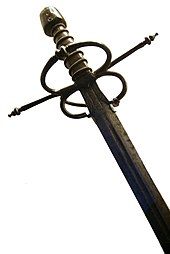

|
No edit summary
|
No edit summary
Tags: Visual edit Mobile edit Mobile web edit
|
||
| Line 4: | Line 4: | ||
[[File:Rapiere-img 0097.jpg|upright|thumb|An early rapier or "side-sword" on exhibit in the [[Castle of Chillon]].]] |
[[File:Rapiere-img 0097.jpg|upright|thumb|An early rapier or "side-sword" on exhibit in the [[Castle of Chillon]].]] |
||
The '''''spada da lato''''' (Italian) or '''''side-sword''''' is a type of [[sword]] popular during the late 15th and early 16th centuries. |
The '''''spada da lato''''' (Italian) or '''''side-sword''''' is a type of [[sword]] popular during the late 15th and early 16th centuries. |
||
It is a continuation of the medieval [[knightly sword]], and the immediate predecessor |
It is a continuation of the medieval [[knightly sword]], and the immediate predecessor of the [[rapier]] of the [[early modern period]]. Side-swords were used concurrently with rapiers as well, particularly for military applications. Its use was taught in the Dardi school of [[Italian school of fencing|Italian fencing]], and was influential on the classical rapier fencing of the 17th century.<ref>{{Cite web |title=The Weapon Arts - Sidesword |url=https://www.academieduello.com/school/the-arts/weapons/weapon-arts/sidesword/ |url-status=dead |archive-url=https://web.archive.org/web/20170401035602/http://www.academieduello.com/school/the-arts/weapons/weapon-arts/sidesword/ |archive-date=1 April 2017 |access-date=17 September 2017 |website=academieduello.com |publisher=AcademieDuello swordfighting school}}</ref> The equivalent Spanish term, ''espada ropera'' ("dress sword") is the origin of the term ''rapier''.{{Citation needed|date=August 2020|reason=Wiktionary along with many other etymological sources indicate that the term ''rapier'' originated from Spanish ''raspar'' meaning "to scrape".}} |
||
Italian antiquarians use the term ''spada da lato'' for rapiers typical of the period of c. 1560–1630, |
Italian antiquarians use the term ''spada da lato'' for rapiers typical of the period of c. 1560–1630, |
||
the Italian term for the fully developed rapier of the later 17th century is ''spada da lato striscia'', or just ''spada striscia'' "strip-sword". |
the Italian term for the fully developed rapier of the later 17th century is ''spada da lato striscia'', or just ''spada striscia'' "strip-sword". |
||
This article needs additional citations for verification. Please help improve this articlebyadding citations to reliable sources. Unsourced material may be challenged and removed.
Find sources: "Spada da lato" – news · newspapers · books · scholar · JSTOR (September 2017) (Learn how and when to remove this message) |

The spada da lato (Italian) or side-sword is a type of sword popular during the late 15th and early 16th centuries. It is a continuation of the medieval knightly sword, and the immediate predecessor of the rapier of the early modern period. Side-swords were used concurrently with rapiers as well, particularly for military applications. Its use was taught in the Dardi school of Italian fencing, and was influential on the classical rapier fencing of the 17th century.[1] The equivalent Spanish term, espada ropera ("dress sword") is the origin of the term rapier.[citation needed] Italian antiquarians use the term spada da lato for rapiers typical of the period of c. 1560–1630, the Italian term for the fully developed rapier of the later 17th century is spada da lato striscia, or just spada striscia "strip-sword".
This sword design eventually led to the development of the civilian rapier, but it was not replaced by it, and the side-sword continued to be used during the rapier's lifetime.[clarification needed][2][3][4]
Although this particular type of sword is referred to in modern times as a side-sword, the name was not used contemporaneously to the sword in question (according to the current research of ancient fighting manuals). Although some early Italian sources use the term spada da lato, they are only talking about the sword that is at one's side, and not just this particular type of sword.[dubious – discuss][5][6]
This article relating to swords is a stub. You can help Wikipedia by expanding it. |
This Italian history article is a stub. You can help Wikipedia by expanding it. |